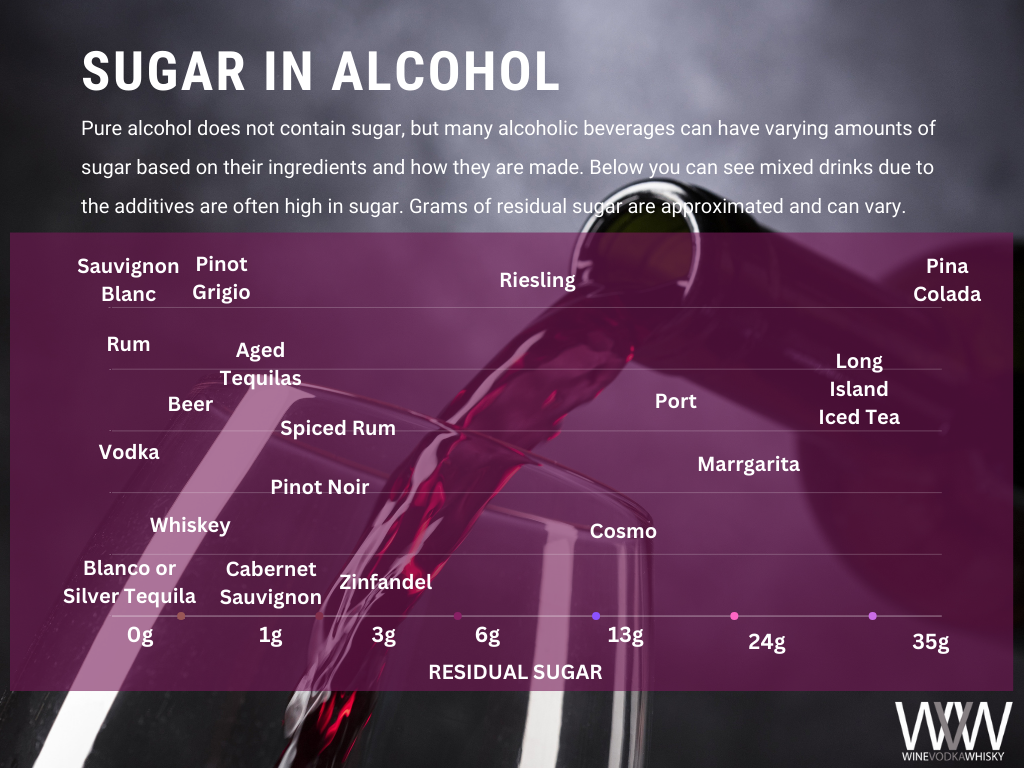Alcohol comes in many flavors, from the rich taste of old whiskey to the cool, fresh taste of a mojito. It can fit many different events and personal tastes. What many people don’t know is that sugar in alcohol is a big reason for this variety. Sugar is very important in making alcohol and affects how we enjoy it in many ways.
Learn how sugar and alcohol work together
Sugar in Alcohol
Does Alcohol Have Sugar?
Pure alcohol itself does not contain sugar, however, many alcoholic beverages can have varying amounts of sugar based on their ingredients and how it’s made. Unlike food, many alcoholic beverages do not require a nutrition facts label, making it harder to know the exact sugar content unless the manufacturer chooses to provide that information.
- Wines: The sugar content in wine can vary. Dry wines have minimal residual sugar, while sweet wines have much more.
- Beer: Traditional beers can have some sugars remaining, but it’s generally not a lot. Some craft beers, especially those with added flavors or heavier bodies, may have more.
- Spirits: Pure spirits like vodka, gin, rum, whiskey, and tequila typically contain no sugar after distillation. However, flavored versions or liqueurs (spirits with added sugar and flavors) can have significant amounts of sugar.
- Mixed Drinks and Cocktails: These can contain a lot of sugar, depending on the ingredients used, such as soda, juice, syrups, and other sweeteners.

Does Alcohol Turn Into Sugar
No, alcohol does not turn into sugar. The alcohol is absorbed directly into your bloodstream, and causes blood sugar levels to drop. This is because the liver is busy processing the alcohol it stops producing glucose. This is a problem for diabetics.
If the drink contains high levels of carbs, like most beers or sweetened mixed drinks, the carbs can cause blood sugar levels to rise. This yo yo affect is why diabetics should not drink alcohol.
Other Common Misconceptions About Sugar in Alcohol
- Darker Liquors Have More Sugar: The color of the liquor (e.g., dark rum vs. white rum) is often believed to indicate higher sugar in alcohol. While darker spirits may have a more complex flavor, the color usually (but not always) comes from aging in barrels, not from sugar.
- Wine is Always a Low-Sugar Option: The sugar content in wine can vary dramatically. While some dry wines may have very little residual sugar, sweet wines (like dessert wines, certain Rieslings, and Moscatos) can contain high levels of sugar. The misconception arises because the alcohol content can mask the sweetness.
- “Sugar-Free” or “Low-Carb” Means No Sugar: Some alcoholic beverages are marketed as “sugar-free” or “low-carb,” which can be misleading. While they may have no added sugar this does not mean they are completely free of sugar, especially if they contain natural sugars from fruits or other ingredients.
- Beer is Always High in Sugar: Beer is often associated with high sugar content because of its carbohydrate levels. However, most of the carbohydrates in beer come from starches, not sugars. The actual sugar content in beer is typically low, although some flavored or specialty beers may have added sugars.
- Clear Spirits are Sugar-Free: While it’s true that distilled spirits like vodka, gin, and tequila do not contain sugar after the distillation process, this misconception leads some to believe that any drink made with these spirits is also sugar-free. The mixers and other ingredients added to cocktails can significantly increase the sugar content.
Sugar and Fermentation
Making alcohol involves fermentation. This is when yeast, a tiny organism, eats up sugar and turns it into alcohol (ethanol) and carbon dioxide gas. This process is key to making drinks with alcohol in them. The kind of sugar used can change how the alcohol tastes and feels. For example, fermenting grapes, which are naturally sweet, makes wine; turning the sugars from grains like barley and corn into alcohol makes beer or whiskey; and using sugarcane or molasses, which are full of a sugar called sucrose, makes rum.
While fermentation is about converting sugar into alcohol, the process of distillation separates alcohol from the sugar.
Aging, and storing alcohol in wooden barrels introduces interaction between the alcohol and the wood, along with any residual sugars, contributing to the development of rich, deep flavors. For example, the caramelized sugars in the charred oak barrels can impart a sweet, toasty flavor to whiskey or bourbon.
The sugars left over in wine can make it dry, somewhat sweet, or very sweet, which really changes how it tastes and feels when you drink it.
Residual Sugar vs Added Sugar
Understanding the nuances between residual sugar and added sugar in alcoholic beverages is important for several reasons.
Residual sugar is essentially the natural sugars that remain in alcohol after the fermentation process has been completed. In wines, for example, it represents the sugars left behind when yeast has transformed the majority of the sugars from grapes (or other foundational ingredients) into alcohol.
Residual sugar plays a key role in the overall flavor profile of the alcohol, contributing to its natural sweetness. However, it’s important to note that the perception of sweetness is balanced with other components such as acidity, tannins, and alcohol content (ABV). This complex interplay means that wines, even those with moderate levels of residual sugar, might not always taste distinctly sweet to every palate.
On the other hand, added sugar refers to any sugar or sweetening agent that is incorporated into the alcohol during its production or preparation, beyond the natural sugars found in the raw ingredients. This covers a wide array of sweeteners, including but not limited to, common table sugar (sucrose), high-fructose corn syrup, and various artificial sweeteners. The purpose of adding sugar can range from enhancing sweetness and flavor to adjusting the texture and mouthfeel of the product.
The health implications of consuming added sugars have become a growing concern, linked to many adverse health outcomes such as obesity, type 2 diabetes, and heart disease. Consequently, health organizations worldwide advocate for the monitoring and reduction of added sugar intake as part of a balanced and healthy diet.
Alcohol By Volume (ABV) Impact On Perceived Sweetness
ABV of a drink plays a significant role in influencing its perceived sweetness. ABV is a standard measure used across the globe to quantify the amount of alcohol (ethanol) in an alcoholic drink.
The human palate can detect five primary tastes: sweet, sour, salty, bitter, and umami. Alcohol’s presence affects these taste perceptions, particularly sweetness and bitterness. High ABV beverages can intensify the bitterness, reducing the prominence of sweetness.
The perception of sweetness in alcoholic beverages is also influenced by other factors, including acidity, tannins, and carbonation. For example, a high-ABV sparkling wine may taste less sweet than a still wine with the same sugar content due to the acidity and carbonation, which can enhance the perception of dryness.
Spirits undergo distillation, which increases alcohol content while removing most sugars, resulting in high-ABV beverages with minimal inherent sweetness.
Tips for Reducing Sugar Intake from Alcoholic Beverages
Reducing sugar intake from alcoholic beverages is an important consideration for many individuals looking to maintain a healthier lifestyle while still enjoying a drink occasionally. Here are practical tips to help you minimize sugar consumption without sacrificing the social and pleasurable aspects of drinking.
Choose Dry Over Sweet
- Opt for dry wines: Dry wines have less residual sugar compared to sweet wines. Look for terms like “dry,” “brut,” or “extra brut” on labels.
- Select light beers: Light beers tend to have lower sugar and carbohydrate content compared to regular or craft beers.
Be Mindful of Mixers
- Use sugar-free mixers: Choose soda water, diet tonic, or zero-calorie flavored waters instead of regular soda, tonic water, or juice.
- Limit pre-made cocktails: Many pre-made or ready-to-drink cocktails are high in added sugars. Making your own drinks allows for better control over the sugar content.
Dilute Your Drinks
Add more ice or water: Diluting your drink with extra ice or a splash of water can lower the overall sugar concentration without dramatically altering the taste.
Watch Out for Flavored Alcohols and Liqueurs
Avoid or limit sweet liqueurs: Liqueurs and flavored spirits often contain added sugars. If you enjoy these, consider using smaller amounts or finding a lower-sugar alternative.
Make Your Own Simple Syrup
Use alternative sweeteners: Create a simple syrup using a sugar substitute that fits your dietary preferences. This allows you to control the sweetness of your homemade cocktails with minimal added sugars.
Final Thoughts
Understanding the role of sugar in alcohol can help you make informed choices and reduce your sugar intake from alcoholic beverages. Opting for dry options, being mindful of mixers, diluting your drinks, and avoiding flavored alcohol and liqueurs are practical strategies to minimize sugar consumption.
Additionally, making your own simple syrup gives you control over the sweetness level. By implementing these tips, you can enjoy your favorite drinks while maintaining a healthier lifestyle.
